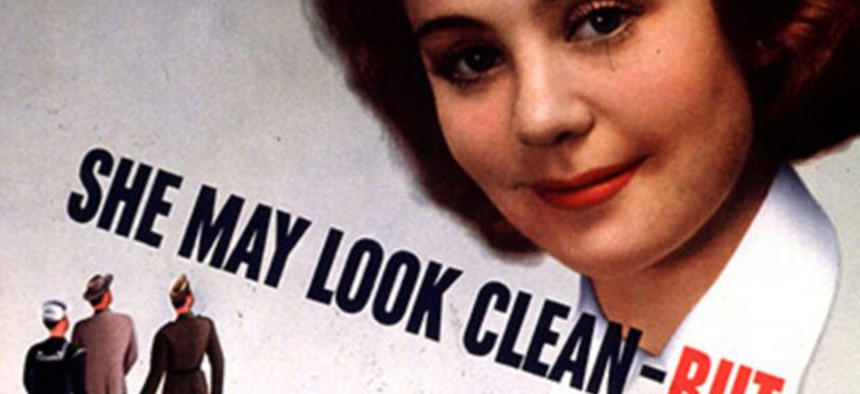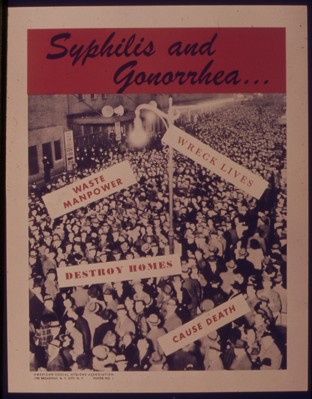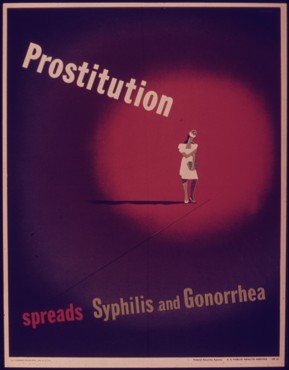
National Archives via Wikimedia
During World War II, Sex Was a National-Security Threat
The government detained and quarantined so-called “patriotutes” to protect soldiers from sexually transmitted diseases.
In June 1942, a woman named Billie Smith was arrested in her hotel room in Little Rock, Arkansas, and charged with prostitution and violation of the state’s immorality laws. Smith pled guilty and paid the fine of $10—equivalent to $150 today—but authorities weren’t quite done.
Smith was turned over to the city’s health examiner, who ran tests for syphilis and gonorrhea. When both came back positive, the officer ordered her committed to a federally run quarantine center in Hot Springs, Arkansas. Three days after her arrest, she petitioned for a writ of habeas corpus, arguing that the quarantine amounted to unlawful imprisonment—but Smith’s condition posed too much of a threat, the court argued, for it to do anything but let the quarantine stand.
“It affects the public health so intimately and so insidiously,” the court wrote, “that consideration of delicacy and privacy may not be permitted to that measures necessary to avert the public peril.”

Technically speaking, the “it” referred to sexually transmitted diseases, which the government had recently declared to be “military saboteur number one.” In practice, though, the real saboteurs were considered to be the women who carried them. Over the course of the United States’ involvement in World War II, federal authorities detained hundreds of women in quarantine centers across the country, determined to protect the country’s fighting men from sex workers and other women who flocked to the towns that housed army bases, known as “Khaki Wackies,” “good-time Charlottes,” “camp followers,” and—in a portmanteau coined by a the U.S. Public Health Service—“patriotutes.”
“Controlling these women was considered important to the defense effort,” said John Parascandola, a medical historian and the author of Sex, Science, and Sin: A History of Syphilis in America. In 1939, three years before Smith’s arrest, the War Deparment, the Navy, the Federal Security Agency, and state health departments crafted the Eight-Point Plan, a set of measures intended to curb the spread of STDs “in areas where armed forces or national-defense employees are concentrated.”
The problem was, treating STDs at the time was often a lengthy and involved process. Penicillin was first used as a treatment for syphilis in 1943, but it was scarce for civilians during the war—the more common treatment at that time was a regular injection of arsenic-based drugs, administered once a week for up to a year. Gonorrhea could be cured with a round of pills, but even that required careful adherence to the dosing schedule in order to work. Counting on such a high degree of cooperation was too much of a gamble.
The strategy, then: Eliminate the need for cooperation.
In 1941, the government created the Social Protection Division, an agency whose goal was to combat prostitution in these areas, and appointed Eliot Ness, a Prohibition agent who had helped indict Al Capone, as its head. The same year also saw the passage of the May Act, which made it a federal offense to solicit sex near a military base.
“Uncle Sam is not taking camp followers for granted,” Ness wrote in 1942. Under his direction, the government opened a network of so-called “rapid treatment centers” across the country, where women—it was almost always women—could be detained and given a concentrated intravenous dose of the syphilis drugs over a period of days or weeks.
At first, health officials focused on sex workers who had been arrested near military bases or factories. As the war progressed, however, the focus widened from sex workers to “any women who were somehow viewed or under suspicion as being delinquent,” Parascandola said. Some places dispatched health workers to bars and dance halls to scout out women who appeared too sexually forward; in other cases, officials would wait at bus stops, questioning the women who came off the bus about their reasons for traveling to the town.
Women who didn’t agree to submit to testing could still be quarantined via court order if officials suspected her of having an STD—a caveat that was interpreted liberally. “For example, they might arrest a woman who they found hanging around the camps under vagrancy charges,” he said, “and they might use some claim of suspicion for venereal disease because this women was hanging around with all these men.”
While the quarantine itself was legal, the treatment was more of a legal gray area—for syphilis, in particular, the insertion of an intravenous line could be considered a surgical procedure, which legally couldn’t be forced. In practice, however, “I’m not sure how much of a choice they had,” Parascandola said. “For one thing, they could keep them quarantined [indefinitely] … They could simply say, ‘If you don’t get treated, you still have the infection and we’re not going to release you.’”

While the centers were primarily hospitals, the staffers frequently tried to “cure” their patients in more ways than one. “There were attempts to counsel them, to set them on the ‘right path,’ if you will,” Parascandola said. Most centers offered vocational training, sometimes funneling the women directly from treatment into jobs at factories that supported the war effort—and by extension, they believed, eliminating the threat of the number-one saboteur.
“A lot of people who were supposedly experts on venereal disease had a ‘one-way transmission idea’ of how it moved. They saw it going from prostitutes to their clients,” said Linda Gordon, a professor of history at New York University. The idea of women as the carriers of STDs and men as the hapless victims wasn’t new—in fact, it was as old as syphilis itself—but it was embedded in the public-health rhetoric of wartime America.
“What you have is not so much what we would consider a scientific conclusion as a sexist bias that saw prostitutes as inherently dirty,” Gordon said. “Polluted, but also polluting to anyone they came across.”
The double standard manifested itself in other ways, too—while condoms were readily available for male soldiers on military bases, the official policy of the Women’s Army Corps was abstinence.






